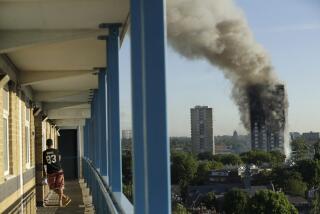Soviets Blame Rushed Testing at Chernobyl
- Share via
VIENNA — An official summary of the Soviet government’s report on the Chernobyl nuclear accident says that it was caused by reactor operators who ignored both established rules of procedure and clear signs of developing trouble as they rushed to complete a planned test on one of the reactor’s turbines.
The summary outlines an accelerating sequence of operator errors and signs of erratic behavior in the 1,000-megawatt reactor itself that began a full 12 hours before a catastrophic explosion blew the top off the reactor early in the morning of April 26 and ignited a graphite fire that spread radioactive contamination around the world.
“Personnel deviated from the planned test program, creating the very conditions in which an accident situation would arise,” the 67-page summary says.
“The basic motivation for the behavior of operating personnel was an effort to finish the experiment faster,” it concludes.
Their behavior, it adds, suggests a “loss of the sense of danger” that is inherent in nuclear energy.
The Russian-language summary condenses a 382-page analysis of the accident prepared by a Soviet government commission and submitted late last week to the International Atomic Energy Agency (IAEA). The IAEA has distributed the summary and the full report to its 110 member governments for discussion at a five-day meeting in Vienna beginning on Monday. The Soviets have asked that the report not be published.
A copy of the summary was made available to The Times by a member government.
Technical experts who have seen the full report said their initial impression is that it is relatively thorough and frank, in contrast with the secrecy with which the Soviets at first treated the accident. The report places heavy emphasis, however, on human error as opposed to any inherent weaknesses that may have existed in the reactor design.
At least 31 people have died so far from injuries and radiation poisoning, about 300 were hospitalized and more than 92,000 people were evacuated from contaminated areas, which covered more than 1,000 square kilometers (386 square miles) of prime farmland. The Soviet government has estimated that direct damages amounted to the equivalent of $2.8 billion.
Computer Turned Off
Nevertheless, the summary observes that “it would be impossible to imagine a future world economy without nuclear energy.” The summary report, translated by The Times, notes that Soviet analysts were hindered in their efforts to analyze the accident by the fact that operators had turned off a computer that automatically and continuously recorded data on conditions within the reactor, and used the computer instead mainly to record data from the test they were to carry out.
As a result, Soviet experts had to rely on a mathematical model, as well as on instrument readings and eyewitness testimony, to reconstruct the accident.
According to the summary report, the sequence of events leading to the accident began at 1 a.m. on April 25, more than 24 hours earlier, as operators began reducing power in the No. 4 unit at Chernobyl for normal maintenance and refueling.
The planned test, on the No. 8 turbine generator, was designed to determine whether kinetic or mechanical energy of the turbine--in effect, its momentum--could be used to drive emergency systems if the plant were disconnected from the electric power grid. In the process, one emergency core cooling system linked to the turbine generator was also disconnected.
“Under prevailing rules, such a test on an operating reactor was not forbidden,” the report says. It notes that “similar tests had already been carried out earlier at this plant.”
Little Attention to Safety
However, this time, it said, the quality of written test procedures was “low,” attention to safety measures was treated as little more than a “formality” and supervisors failed to ensure that specialists were on hand “in the event of an accident situation.”
In retrospect, the first major operator error was said to have occurred 12 hours later, at 1 p.m. on April 25, when a second turbine, the No. 7, was also shut down in violation of the test plan. An hour later, its associated emergency cooling system was also disconnected.
Operators later explained, the report says, that they had planned to switch the test to this turbine if the first attempt on the No. 8 turbine was not successful.
However the report continues, the reactor’s safety design “did not envision” the possibility that two sets of emergency systems would be deliberately disconnected at the same time.
During the rest of April 25, operators gradually reduced reactor power until 11:10 p.m. that night, when they observed unexplained fluctuations--a sharp drop--in power. About two hours later, at 1 a.m. on Saturday, April 26, operators had stabilized the reactor at 200 megawatts of thermal power, only to find that a buildup of xenon, a gaseous contaminant, was causing an uneven and potentially dangerous distribution of power in the reactor core.
Chain-Reaction of Problems
Over the next 20 minutes, each effort to solve this problem led to yet another. The flow of feedwater into the cooling system fluctuated, and the power profile in the core grew more uneven.
As they grappled with these snowballing problems, the unnamed operators are said to have committed yet another major error by cutting off “emergency protection signals,” which apparently indicated such vital data as internal reactor temperature and water flow.
“Despite all this,” the report observes, “it was decided to conduct the experiment.”
“Under established procedures,” the report continues, the reactor’s erratic behavior as of 1:22:30 a.m. on April 26 “required immediate shutdown. Nevertheless, the operator did not stop (the reactor) and the experiment was begun.”
In a few moments, reactor power began to rise; then in the span of three seconds, it shot up 530 megawatts.
One minute 10 seconds into the experiment, the shift chief “gave the command to press the AZ-5 (emergency shutdown) button, a signal from which would insert all control rods into the core.” But the reactor was now beyond control.
Control Rods Jammed
Seconds later, a shudder shook the reactor building and the control rods jammed part way down.
In a last-resort effort to stop the nuclear chain reaction, operators then disconnected the servo-motors driving the control rods, so as to let the rods fall by their own weight into the core.
This maneuver also failed. Fuel rods now were overheating and bursting, and a shattering steam explosion ripped off the top of the reactor and breached enclosing buildings. A heavy refueling crane toppled into the open reactor, rupturing still more fuel.
Inside the control room, the report says, operators at about 1:24 a.m. heard two successive explosions. While the report says there was no meltdown of fuel, the super-heated tubes of zirconium alloy that contained the uranium fuel reacted chemically with water to produce hydrogen gas.
Water mixed with burning graphite generated still more hydrogen, carbon monoxide and heat. Inrushing air brought oxygen, triggering the explosions.
Ignited 30 Fires
As burning debris and sparks flew across the roof of the adjacent turbine hall, they ignited 30 fires simultaneously. Inside the reactor core, graphite continued to burn, sending a plume of radioactive fission wastes into the atmosphere and ultimately around the world, until military helicopters quenched the fire with 5,000 tons of smothering sand, lead and boron.
The report indicates that the accident occurred at the worst possible stage in the reactor’s life, when its fuel had been largely burned and accumulated fission wastes were at a maximum level. The report said 75% of the fuel had been burned to the high level of 12,000 to 15,000 megawatt-days per ton.
Although only 3.5% of the fission wastes were said to have escaped, the report says this amounted to 50 million curies of radioactive material.
These figures, however, appear to apply only to contamination on Soviet territory. The summary notes that radioactivity was “dispersed over great distances over the territory of Byelorussia, the Ukraine and the Russian Republic,” but it makes no mention of fallout crossing Soviet borders.
According to some Western analysts, the 50 million curies far exceeds the amount of radioactivity released by the two atomic bombs the United States dropped on Japan in World War II.
More to Read
Sign up for Essential California
The most important California stories and recommendations in your inbox every morning.
You may occasionally receive promotional content from the Los Angeles Times.













